|
1.
Olive oil production in the North Aegean Region
2.
Olive mill waste and treatment methods
3.
Legislation in force regarding the Disposal of Olive Mill Waste
Olive oil production in the North Aegean Region
For
many centuries olive oil production has been a
particularly developed practice on the islands of the
North Aegean. The high economic growth the island
economies enjoyed from the 19th century
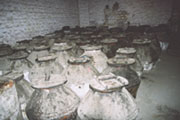 until the
beginning of the 20th century is largely
attributed to the flourishing olive oil production
sector. This economic growth was due to the fact that
the olive products (olive oil, pomace, soap) were of
significant economic value on one hand, and that until the
beginning of the 20th century is largely
attributed to the flourishing olive oil production
sector. This economic growth was due to the fact that
the olive products (olive oil, pomace, soap) were of
significant economic value on one hand, and that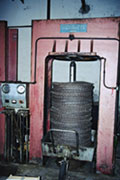 a
particular trading relationship, based on these products,
was developed between the N. Aegean islands and the
coasts of Minor Asia and Istanbul. Even today olive
production plays a leading role in the economy of most
islands which is confirmed by its contribution to the
GDP. On Lesvos for example, the olive industry accounts
for 3,6% up to 15,3% of the GDP, depending on the olive-growing
period.
a
particular trading relationship, based on these products,
was developed between the N. Aegean islands and the
coasts of Minor Asia and Istanbul. Even today olive
production plays a leading role in the economy of most
islands which is confirmed by its contribution to the
GDP. On Lesvos for example, the olive industry accounts
for 3,6% up to 15,3% of the GDP, depending on the olive-growing
period.
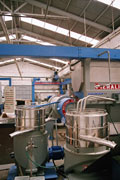 There are 107 olive mills in
operation in the Northern Aegean Region; 71 of these are
found on Lesvos, 14 on Chios, 13 on Samos and 9 on
Ikaria island. Most of the olive mills are of a
relatively low capacity (between 1,5 and 2,5 tons of
olives per hour) and are scattered all over the island.
About 75% of them are located within settlements. The
dominant type of olive mill is the centrifugal type with
the exception of only 4 olive mills on Chios and Ikaria,
that apply the traditional hydraulic press process for
olive oil extraction. On Lesvos 55% of the olive mills
are co-operative based, unlike the case on other islands
where almost all of the olive mills are privately owned. There are 107 olive mills in
operation in the Northern Aegean Region; 71 of these are
found on Lesvos, 14 on Chios, 13 on Samos and 9 on
Ikaria island. Most of the olive mills are of a
relatively low capacity (between 1,5 and 2,5 tons of
olives per hour) and are scattered all over the island.
About 75% of them are located within settlements. The
dominant type of olive mill is the centrifugal type with
the exception of only 4 olive mills on Chios and Ikaria,
that apply the traditional hydraulic press process for
olive oil extraction. On Lesvos 55% of the olive mills
are co-operative based, unlike the case on other islands
where almost all of the olive mills are privately owned.
Top
Olive Mill Waste Treatment Methods
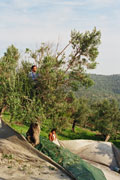 A number of by-products are produced during the olive oil
production process. These are the pomace, which
consists of mainly the pits of the fruits and solids
after pressing, olive leaves, that are carried away with the olives as the latter are being
collected, and a significant quantity of vegetable water
of high organic load, known as “liozoumi”,
“katsigaros” or “mourga”. A number of by-products are produced during the olive oil
production process. These are the pomace, which
consists of mainly the pits of the fruits and solids
after pressing, olive leaves, that are carried away with the olives as the latter are being
collected, and a significant quantity of vegetable water
of high organic load, known as “liozoumi”,
“katsigaros” or “mourga”.
The
vegetable water or “katsigaros” (OMW) consists of the liquid
fraction of the olive juice and the water used during
the different phases of olive mill processing.
Essentially it is an aqueous vegetable extract,
containing a number of substances such as sugers,
nitrogenous compounds, organic acids, polyalcohols,
polyphenols and oil residue. The direct impact that
vegetable water has on the environment is the aesthetic
degradation caused by its strong odor and dark color.
Furthermore, due to its high organic load, this
vegetable water is likely to cause eutrophication in
cases where it ends up in recipients where exchanging
rates are low (closed gulfs, lakes etc). Of all
components, the polyphenols are the most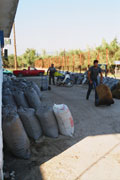 interesting.
This is owing to their toxic properties that may affect
plants. Furthermore they have a relatively slow
degradability rate by specialized groups of micro-organisms.
On the other hand the polyphenols ensure that olive oil
retains its quality over time (low acidity), acting as a
natural preservative. It should be noted that the
production of olive oil is a natural process, and thus
the olive mill wastewater does not contain other
substances that are highly toxic, such as heavy metals
and synthetic organic compounds. interesting.
This is owing to their toxic properties that may affect
plants. Furthermore they have a relatively slow
degradability rate by specialized groups of micro-organisms.
On the other hand the polyphenols ensure that olive oil
retains its quality over time (low acidity), acting as a
natural preservative. It should be noted that the
production of olive oil is a natural process, and thus
the olive mill wastewater does not contain other
substances that are highly toxic, such as heavy metals
and synthetic organic compounds.
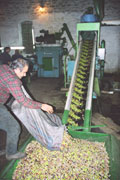 Direct
dumping of olive mill wastewater in the environment is
unacceptable due to its high organic load and the
presence of polyphenols. Thus treatment is required
prior to disposal. Various olive mill wastewater
treatment and disposal methods have been tested both in
vitro and in vivo. However, despite efforts, an
integrated solution has not yet been proposed and the
techniques that have been applied in each individual
case present certain technical and/or economic
disadvantages and have failed to provide a satisfactory
solution to the problem. Direct
dumping of olive mill wastewater in the environment is
unacceptable due to its high organic load and the
presence of polyphenols. Thus treatment is required
prior to disposal. Various olive mill wastewater
treatment and disposal methods have been tested both in
vitro and in vivo. However, despite efforts, an
integrated solution has not yet been proposed and the
techniques that have been applied in each individual
case present certain technical and/or economic
disadvantages and have failed to provide a satisfactory
solution to the problem.
More
specifically, evaporation ponds have been applied in
Crete, simple ground pits in Chios and soil applications
in Cyprus which are methods that require large areas of
land for the disposal of the waste and often create
aesthetic problems as a result of the frequently
occurring poor layout and construction of these systems.
Olive mills in Spain have been transformed into two-phase
mills rather than three-phase, which considerably
reduces the volume of water required by the olive mill
and volume of wastewater produced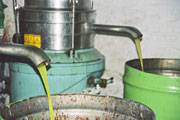 accordingly. However
it alters the problem, by producing an olive pomace/
wastewater mixture which must then be treated. At the
same time, in Kalamata an effort was made on a pilot
scale to produce a liquid soil enhancer or compost from
OMW (Crete, Kalamata), which is a process that
presupposes the existence of a sufficient market for the
products produced. Chemical oxidation and anaerobic
digestion of olive mill wastewater have been applied in
Crete, which are techniques with high operational and
construction costs. Another effort initiated on Crete is
to achieve the co-treatment of OMW and municipal sewage
in artificial biotopes or in active municipal waste
water treatment plants. This technique requires a
significant dilution of the OMW. Finally, the separation
of OMW into fractions by natural sedimentation has been
attempted on Samos, which is a technique that requires
combination with one of the other methods mentioned
above in order ensure a satisfactory level of treatment.
accordingly. However
it alters the problem, by producing an olive pomace/
wastewater mixture which must then be treated. At the
same time, in Kalamata an effort was made on a pilot
scale to produce a liquid soil enhancer or compost from
OMW (Crete, Kalamata), which is a process that
presupposes the existence of a sufficient market for the
products produced. Chemical oxidation and anaerobic
digestion of olive mill wastewater have been applied in
Crete, which are techniques with high operational and
construction costs. Another effort initiated on Crete is
to achieve the co-treatment of OMW and municipal sewage
in artificial biotopes or in active municipal waste
water treatment plants. This technique requires a
significant dilution of the OMW. Finally, the separation
of OMW into fractions by natural sedimentation has been
attempted on Samos, which is a technique that requires
combination with one of the other methods mentioned
above in order ensure a satisfactory level of treatment.
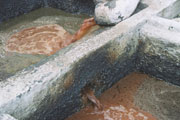 Over the last years the recovery of polyphenols
from
OMW has been achieved in the laboratory using membranes, for
the purpose of application in the perfume and
pharmaceutical industry. Although the above utilization
of olive mill waste is technically feasible, it is too
early to achieve large-scale application. Over the last years the recovery of polyphenols
from
OMW has been achieved in the laboratory using membranes, for
the purpose of application in the perfume and
pharmaceutical industry. Although the above utilization
of olive mill waste is technically feasible, it is too
early to achieve large-scale application.
It should be noted that, due to the great variation in
the characteristics of the olive mills (geographic
position, capacity, location, water usage etc.), but
also in the quality and quantity of the waste produced,
a single solution that would be immediately applicable
in all the olive mills of the North Aegean Region does
not appear to exist.
Top
Regulations
in force for OMW Disposal
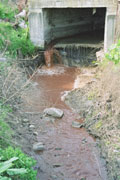 Lesvos: The
standing practice in
the 71 olive mills on the island continues to be the
unrestrained dumping of OMW in torrents/streams and ends
up reaching its final recipient, the sea. A provisionary
attempt to confront the problem was proposed by the
Prefecture of Lesvos. This consisted of the addition of
lime to the OMW before
its disposal to the natural recipients, in order to
lower the pollutant load. There is overall agreement
that the proposed treatment system (that has been
applied in only 2 olive mills on Lesvos where it is not
applied in daily practice) requires improvements and
additions. Thus the Prefecture of Lesvos has extended
the period of putting technical applications into
practice and a final decision based on the results of
NAIAS programme currently underway is expected to be
reached. Lesvos: The
standing practice in
the 71 olive mills on the island continues to be the
unrestrained dumping of OMW in torrents/streams and ends
up reaching its final recipient, the sea. A provisionary
attempt to confront the problem was proposed by the
Prefecture of Lesvos. This consisted of the addition of
lime to the OMW before
its disposal to the natural recipients, in order to
lower the pollutant load. There is overall agreement
that the proposed treatment system (that has been
applied in only 2 olive mills on Lesvos where it is not
applied in daily practice) requires improvements and
additions. Thus the Prefecture of Lesvos has extended
the period of putting technical applications into
practice and a final decision based on the results of
NAIAS programme currently underway is expected to be
reached.
-Samos
- Ikaria:
To be updated shortly.
|















